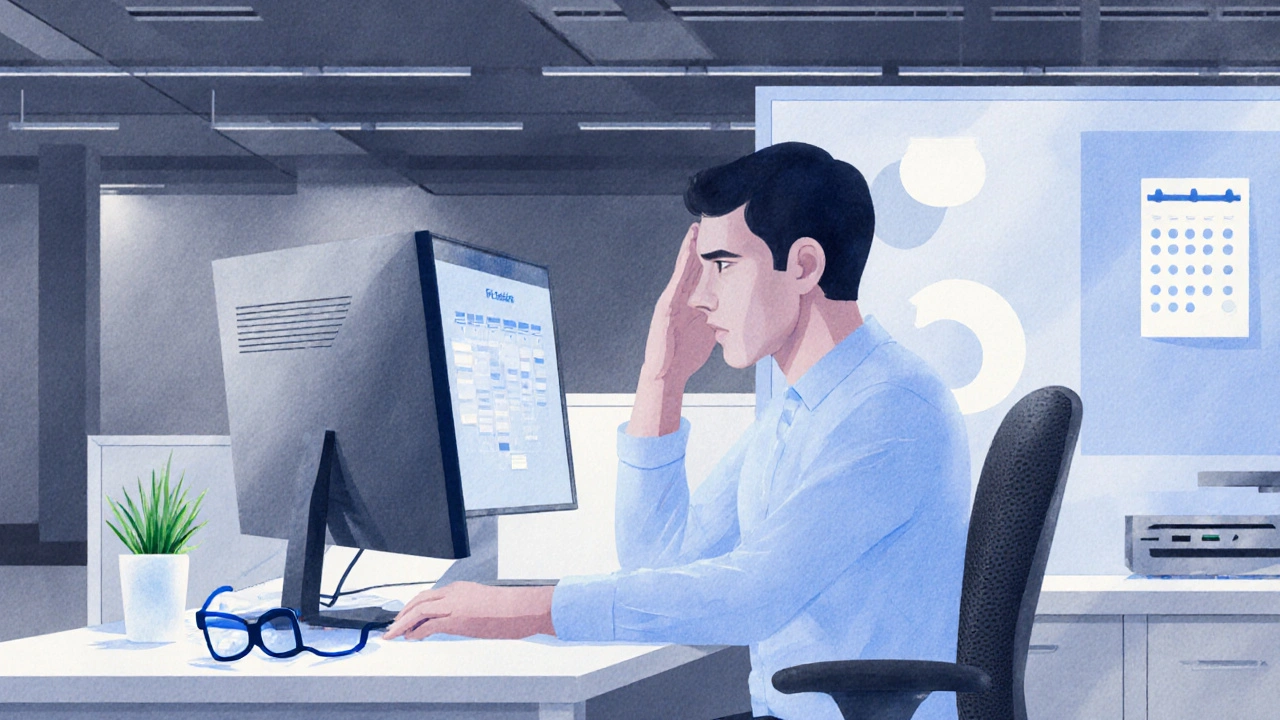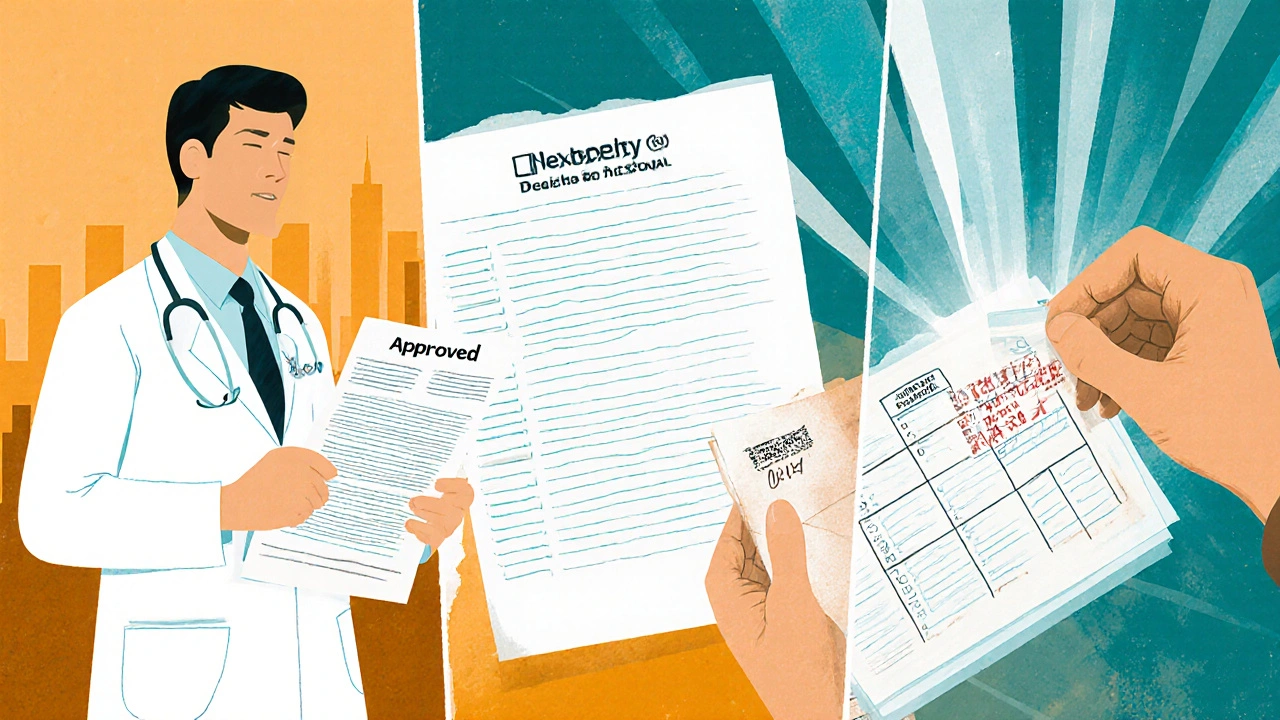Migraine Disability Benefits Calculator
Your Migraine Profile
Please answer the following questions to determine your potential disability benefit eligibility.
Your Benefit Eligibility Report
Recommended Actions:
Living with frequent migraine attacks can feel like walking a tightrope between daily life and a sudden shutdown. When the pain spikes, you might wonder: does migraine count as a disability? How do you tap into insurance benefits? What rights do you have at work? This guide walks you through the real‑world steps to turn those questions into concrete actions.
Quick Summary
- Migraine can qualify as a disability under the ADA if it substantially limits major life activities.
- Short‑term disability (STD), long‑term disability (LTD), and workers’ compensation each have distinct eligibility rules for migraine.
- Employers must provide reasonable accommodations - such as flexible schedules or a quiet workspace - unless it causes undue hardship.
- Key legal shields include the Americans with Disabilities Act (ADA) and the Family and Medical Leave Act (FMLA).
- Documenting attacks, using a migraine diary, and following a step‑by‑step filing checklist dramatically improve claim success.
Understanding Migraine as a Disability
Migraine is a neurological disorder characterized by recurrent, moderate to severe headaches, often accompanied by nausea, light sensitivity, and visual disturbances. While many people experience occasional episodes, chronic migraine - defined as 15 or more headache days per month for three months or more - can severely restrict daily activities.
The Americans with Disabilities Act (ADA) defines a disability as a physical or mental impairment that substantially limits one or more major life activities, such as working, concentrating, or seeing. Courts have increasingly recognized chronic migraine as meeting this threshold when attacks are frequent, unpredictable, and require ongoing treatment.
Key indicators that migraine may be deemed a disability:
- Medical documentation confirming diagnosis and treatment history.
- Evidence that attacks prevent normal work performance or attendance.
- Consistent use of prescription or preventive therapies.
Insurance Pathways for Migraine‑Related Disability
When migraine starts to interfere with earning a living, insurance benefits become a lifeline. Three main streams exist:
| Benefit Type | Typical Coverage Duration | Eligibility Triggers | Average Payout % of Salary |
|---|---|---|---|
| Short‑Term Disability (STD) | Up to 6 months | Medical certification of migraine attack lasting >7 days or multiple episodes within a 30‑day window | 55‑70% |
| Long‑Term Disability (LTD) | 6 months to retirement | Chronic migraine confirmed by neurologist, usually after STD exhaustion | 60‑80% |
| Workers' Compensation | Varies by state (typically 2 years) | Work‑related trigger documented (e.g., bright screen, stressful environment) and employer acknowledgement | Varies; often covers medical costs plus a portion of wages |
How to decide which route fits your situation:
- Start with short‑term disability. Most employer plans automatically cover up to 6 months of leave for acute migraine attacks.
- If attacks persist beyond STD, talk to your HR about transitioning to long‑term disability. A neurologist’s letter that outlines prognosis is crucial.
- Consider workers’ compensation only when a specific workplace factor can be directly linked to an attack. This path often requires an incident report and may involve state agency reviews.

Workplace Accommodations and Legal Protections
Beyond insurance, the law obliges employers to adjust the work environment when migraine qualifies as a disability. The process begins with a reasonable‑accommodation request.
Reasonable accommodation means any modification or adjustment that enables an employee with a disability to perform essential job functions. Common migraine‑friendly accommodations include:
- Flexible start/end times to avoid peak‑trigger periods.
- Permission to work from a dimly lit or quiet space.
- Provision of anti‑glare screen filters or computer glasses.
- Scheduled break windows for quick meditation or medication.
- Allowance for occasional remote work during severe episodes.
Under the ADA, employers must engage in an interactive process - a good‑faith dialogue where both sides discuss the employee’s needs and the employer’s operational constraints. If an accommodation would cause undue hardship (e.g., significant cost or disruption), the employer can propose an alternative, but must still demonstrate why the original request is infeasible.
Additionally, the Family and Medical Leave Act (FMLA) provides up to 12 weeks of unpaid, job‑protected leave for serious health conditions, including chronic migraine, if the employer has 50+ employees within a 75‑mile radius.
Practical Strategies to Reduce Migraine Triggers at Work
Accommodations are most effective when paired with personal migraine‑management habits. Here are tried‑and‑true tactics:
- Keep a migraine diary. Record onset time, triggers, medication, and work impact. The data strengthens insurance claims and accommodation requests.
- Optimize lighting - use task lighting, avoid fluorescent flicker, and consider blue‑light filters.
- Stay hydrated; keep a water bottle at your desk.
- Schedule high‑focus tasks during your “good” windows, usually mid‑morning after breakfast.
- Practice brief relaxation drills (e.g., 4‑7‑8 breathing) during short breaks to lower stress levels.
Step‑by‑Step Checklist for Filing and Requesting
- Obtain a formal diagnosis from a neurologist and request a detailed medical report.
- Log at least four migraine episodes in a diary, noting severity and work impact.
- Review your employee handbook for STD/LTD policy language and deadlines.
- Submit a written accommodation request to HR, attaching your medical documentation and suggested adjustments.
- If denied, ask for a written explanation and request an interactive‑process meeting.
- File the STD claim within the employer‑specified window (often 30 days after onset).
- Should STD be exhausted, transition to LTD by providing updated neurologist notes and a prognosis.
- Consider filing a workers’ compensation claim only after documenting a specific workplace trigger and notifying your supervisor.
- Maintain copies of all correspondence, claim forms, and doctor notes for at least three years.
Common Pitfalls and How to Avoid Them
- Missing documentation deadlines. Insurance carriers often reject claims that arrive after the policy’s filing window - set calendar alerts as soon as an attack occurs.
- Overlooking the interactive process. If you simply quit your job without requesting accommodations, you may lose legal protection.
- Relying on verbal promises. Get any accommodation agreement in writing, even if it’s an email from HR.
- Neglecting self‑care. Even with benefits, unmanaged triggers can lead to claim denials due to “lack of proper treatment.”
- Assuming all insurers treat migraine the same. Review your policy’s definition of “disability” - some require a minimum duration of incapacity that differs from others.

Frequently Asked Questions
Can occasional migraine qualify for disability benefits?
Typically, insurers look for chronic or severe migraine that limits daily activities for a sustained period. Isolated attacks usually don’t meet the threshold unless they result in a prolonged hospital stay or surgery.
What if my employer doesn’t have a formal accommodation policy?
You can still invoke the ADA. Send a written request referencing the ADA and include medical documentation. The employer must engage in the interactive process, even without a pre‑existing policy.
How long does it take for STD or LTD to approve a migraine claim?
STD decisions often arrive within 30‑45 days after full paperwork is submitted. LTD can take longer, typically 60‑90 days, because it may require a second medical opinion.
Are there tax implications for receiving disability benefits?
STD benefits paid through an employer‑sponsored plan are usually tax‑free if premiums were paid with pre‑tax dollars. LTD benefits may be taxable, depending on how premiums were funded. Check IRS Publication 502 for details.
Can I use FMLA and disability benefits together?
Yes. Many employees take FMLA leave first (unpaid but job‑protected) and then transition to paid disability benefits. Coordinate with HR to ensure both coverages align without gaps.


Joseph Bowman
October 1, 2025 AT 21:04Ever wonder why the insurance companies love to hide the real criteria for migraine disability behind a maze of legal jargon?
They claim it’s all about medical documentation, but the hidden agenda is to keep the payouts low.
The subtle pressure to label migraine as ‘just a headache’ is a classic control tactic.
When you file a claim, the system automatically cross‑references your diary with an algorithm nobody can see.
If the algorithm decides you don’t meet the obscure threshold, they reject you without a real explanation.
That’s why keeping a meticulous migraine log is not just good practice, it’s a shield against bureaucratic oblivion.
Document the time of day, the light levels, the stressors, and the exact medication you took.
The more data you feed, the harder it is for the hidden filters to silence you.
And don’t forget to request a neurologist’s letter that explicitly mentions ‘chronic migraine’ as a disabling condition.
The letter should reference the International Headache Society criteria, because that’s the language insurers reluctantly respect.
When you approach HR, frame it as a request for ‘reasonable accommodation under the ADA’ rather than a demand for cash.
Employers are legally bound to engage in an interactive process, even if they pretend they don’t understand your condition.
If they stall, remind them that a written denial can be challenged under the EEOC guidelines.
In short, treat the system as a puzzle you can solve with patience, paperwork, and a dash of healthy skepticism.
Stay vigilant, and the benefits you deserve will eventually break through the veil.
Singh Bhinder
October 2, 2025 AT 13:44The guide nails the core steps for anyone stuck in the maze of disability paperwork.
Starting with a proper diagnosis is essential, because insurers love a clear medical label.
Tracking each migraine episode turns vague complaints into solid evidence.
When you submit the short‑term disability claim, include the neurologist’s letter and at least four diary entries.
If the claim gets denied, use the denial as a trigger for the interactive process with your employer.
Kelly Diglio
October 3, 2025 AT 06:24It can feel overwhelming to navigate the legal and medical hoops, but you’re not alone in this journey.
Taking the time to compile thorough documentation will significantly improve your chances.
Remember that the ADA recognizes chronic migraine as a legitimate disability when it substantially limits major life activities.
Engaging your HR department early, with a well‑written accommodation request, often leads to a smoother resolution.
Keep copies of every form, email, and medical note – they become your safety net if disputes arise.
Your health comes first, and the system, though cumbersome, does have pathways to protect you.
Carmelita Smith
October 3, 2025 AT 23:04Take those breaks-you’ve earned them 😊.
Liam Davis
October 4, 2025 AT 15:44Here’s a quick checklist that you can paste into a note app:
1. Schedule an appointment with a neurologist who specializes in chronic migraine.
2. Request a detailed medical report that cites the International Headache Society criteria.
3. Begin a migraine diary immediately – note date, time, triggers, medication, and work impact.
4. Review your employee handbook for STD/LTD policy language; mark any deadlines.
5. Draft a written reasonable‑accommodation request referencing the ADA, and attach the doctor’s letter.
6. Submit the STD claim within the window (often 30 days) and keep a copy of the submission receipt.
7. If STD runs out, transition to LTD with an updated prognosis from your neurologist.
8. For workplace‑triggered attacks, document the incident and file a workers’ compensation claim, if applicable.
9. Store every email and form in a dedicated folder – the IRS and EEOC love paper trails.
10. Follow up politely every two weeks; persistence often nudges the process forward.
Arlene January
October 5, 2025 AT 08:24Those steps might look like a lot, but break them into bite‑size tasks and tackle one each day – you’ll be surprised at how quickly progress adds up.
Think of your diary as a superhero cape; every entry gives you more power to claim the benefits you deserve.
And remember, you have a legal right to a workplace that doesn’t sabotage your health, so stay confident when you speak up.
Kaitlyn Duran
October 6, 2025 AT 01:04It’s wild how many people overlook simple lighting tweaks that can cut migraine frequency dramatically.
A dimmer switch or a glare‑free monitor can be a game‑changer without any paperwork.
Terri DeLuca-MacMahon
October 6, 2025 AT 17:44💪 Keep pushing forward, folks! Every piece of documentation you add is like adding a brick to the foundation of your claim.
Don’t let a single denial shake your confidence – the system expects you to be persistent.
Stay optimistic, stay organized, and the support you need will eventually arrive.
gary kennemer
October 7, 2025 AT 10:24When we talk about disability, we’re really discussing society’s willingness to acknowledge invisible pain as a real barrier.
Philosophically, the line between a ‘medical condition’ and a ‘disability’ is drawn by collective perception, not just biology.
Thus, the more we document and share our experiences, the more that line shifts toward inclusion.
Payton Haynes
October 8, 2025 AT 03:04Everything they tell you about “standard procedures” is just a smokescreen.
They want you to accept low payouts while they keep the big bucks.
Earlene Kalman
October 8, 2025 AT 19:44This whole system is a circus, and the clowns are the insurance adjusters who think a migraine isn’t real until it hits their paycheck.
Brian Skehan
October 9, 2025 AT 12:24Look, I’ve seen dozens of people try to fight the insurance giants, and most end up exhausted, filing endless forms that lead nowhere.
Their “reasonable accommodations” often turn into vague promises that evaporate when the next budget meeting starts.
It’s a classic power play: give you just enough hope to keep you in the loop, then pull the rug when you’re most vulnerable.
Don’t be fooled by the glossy pamphlets; they’re designed to make you feel heard while they silently count the savings.
If you do decide to push forward, arm yourself with relentless documentation and a lawyer who actually cares about your case.
Otherwise, you’ll be stuck in a loop of denial after denial, watching your health deteriorate under a banner of “policy compliance.”
Stay skeptical, stay organized, and remember that the system thrives on your silence.
Andrew J. Zak
October 10, 2025 AT 05:04Thanks for sharing all these perspectives – it really shows how much strength can come from community knowledge.
Keep the conversation going, and let’s keep each other empowered with facts and encouragement.